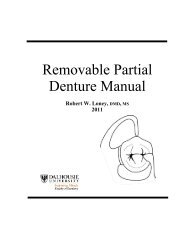Manuals_files/CD Manual 12.pdf - Removable Prosthodontics
Manuals_files/CD Manual 12.pdf - Removable Prosthodontics
Manuals_files/CD Manual 12.pdf - Removable Prosthodontics
Create successful ePaper yourself
Turn your PDF publications into a flip-book with our unique Google optimized e-Paper software.
Selecting & Setting Teeth - 54<br />
- Set the maxillary teeth, then the mandibular antagonist<br />
- The posterior teeth should be set to follow the occlusal plane of the record base - the<br />
teeth should not be set on a plane higher than that intersecting a point 1/2-2/3 up the<br />
retromolar pads<br />
! In some cases where there is a ridge size discrepancy or skeletal malocclusion, the tooth<br />
positions may have to be modified into cross bite positions. Often it is easier to set<br />
cuspless teeth in a monoplane scheme, because it is not necessary for cusps and fossae to<br />
interdigitate<br />
! Don’t let the record base dictate the buccolingual inclination of teeth:<br />
Achieving a Balanced Lingualized Occlusion<br />
- Normally, when the mandible moves in<br />
lateral or protrusive directions, the condyles<br />
move down the slope of the glenoid fossae,<br />
causing the whole mandible to move<br />
downwards and the posterior teeth to<br />
separate. This is separation, called<br />
Christensen’s phenomenon, makes any balanced occlusion (such as lingualized<br />
occlusion) more difficult. When condylar inclination is steep, using a shallow<br />
cusped tooth (e.g. Anatoline), rather than a non-cusped mandibular tooth for<br />
will make balancing easier to achieve.















